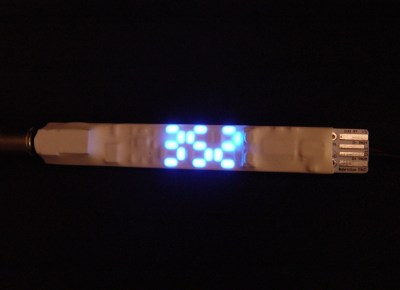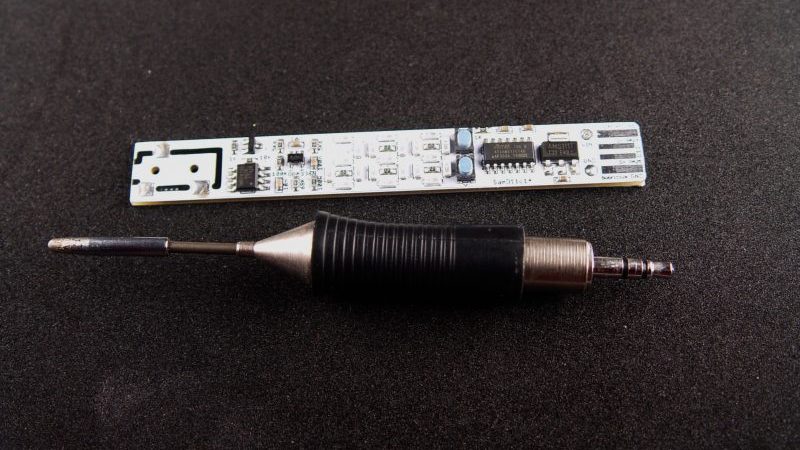A device that even DIY enthusiasts don’t usually think to DIY is the humble soldering iron. Yet, that’s exactly what one Hackaday.io user did by building a USB-powered soldering pen with better performance than a $5 Chinese soldering pen.
 The project draws inspiration from another Weller RT tip-based soldering pen by [vlk], although this project has a simpler display than an OLED. Slovakia-based maker [bobricius] was inspired by the DiXi ATSAMD11C14-based development board. The project uses the same 32-bit ATMEL ARM microcontroller with a USB bootloader, which makes updating the firmware a lot easier.
The project draws inspiration from another Weller RT tip-based soldering pen by [vlk], although this project has a simpler display than an OLED. Slovakia-based maker [bobricius] was inspired by the DiXi ATSAMD11C14-based development board. The project uses the same 32-bit ATMEL ARM microcontroller with a USB bootloader, which makes updating the firmware a lot easier.
Two buttons control the heat (+/-) and the jack for the Weller RT soldering tip controls the power out with PWM. For the display, 20 Charlieplexed 3014 LEDs are used to show the temperature from 0-399. The last missing LED is left out since 5 GPIO pins can only drive 20 LEDs.
Assuming that the main heating controls stay the same as [vlk]’s project, the pen uses a current sensor and heating controller for PID control of a heating module, which connects to the SMT connector for the Weller RT soldering iron tip. The temperature sensor uses a an op-amp for amplification of the signal from a type K thermocouple.
While there aren’t currently GERBER files for the PCB yet, the project is based on the open-source OLED display soldering pen project by [vlk], whose schematic for the device is published.



















Amazed an ordinary 3.5mm audio socket can carry the power required to heat a tip! I’m sure that new knowledge will be useful some day…
I did the USB C power conversion for the TS100 featured on HaD a week or two ago. So convenient, highly recommended. Working with such a lightweight iron is a revelation. My trusty ESRA iron doesn’t get a look in now.
Not just any ordinary 3.5mm connectors. The ones you want should be rated for reflow as they can withstand the high heat without damages. Plastics parts for through hole ones may not take the heat.
Some Vaporizers can heat a 200W element in seconds.
Do they use 3.5mm audio sockets too?
They are useing ni-chrome wire. They make cig lighters that do that too, and toasters! Hmmm, soldering iron seems like a good idea…
I don’t want to think about how dangerous it is to draw that amount of (over) current from a tiny LiPo battery obviously without a overcurrent protection circuit.
well for one thing 200W is serious overkill. Second there is no reason not to have a charge controller on it. third, i guess, the amount of time that is required to form a solder joint is nothing compared to a constant use circuit.
The title of the article took me back to December of 1969, when I got a Heathkit soldering iron for Christmas. This wasn’t an ordinary iron; it used a GE 20 V cartridge and a multi-tap step-down transformer to control the heat.
Quite seriously, there were instructions that told you how to put this together if you didn’t have another soldering iron, which involved crimping all of the connections with pliers, plugging it in, turning it on, waiting for it to heat up, then unplugging it and soldering as many connections as you could, and repeating this process until completed.
I wonder if you could make an iron that used a 2.4v LTO battery for quick bursts of heat and brief cordless operation, and then recharged from USB.
I highly doubt a pro 70W iron really uses 70W most of the time, so USB may well be enough power for a really good iron.
the problem with usb (except C) is the current. a regular 18650 works well for that though. I make cigarette lighters out of an 18650 and a piece of nichrome wire.
I still think USB might be enough. They already have crappy USB irons, and you only need enough power to keep the tip hot, the power to actually heat the joint is provided by the LTO battery.
Duty cycle might not be great, but I’d buy something tiny and cheap that worked well and could do five joints a minute, if they could do it.
The funny thing about this is that you would use reflow – hot air or oven to assemble the board. So the paradox does not exist. After building it, you might prefer it more than hand soldering and only use the iron for touch ups or through hole parts. :P
Well, you *could* use reflow. I’d just hand solder it. The LEDs might be tricky, but I’d probably try to use an OLED if I was going to do this.
Momma said if you solder your own soldering iron you’ll go blind.